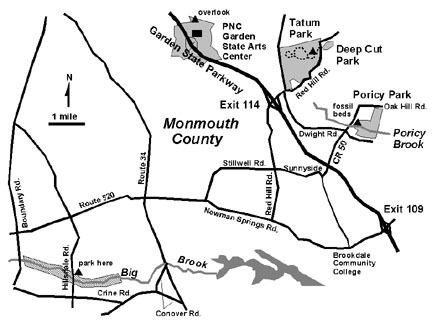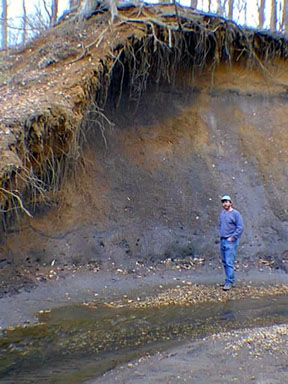52. Poricy Brook
Poricy Park is in Middletown Township in Monmouth County. The municipal park is well known for its Cretaceous shell beds exposed in cut banks along the Poricy Brook (Figure 128). These marine shell beds of the Late Cretaceous Navesink Formation consist dominantly of the large extinct oyster species, Pyncnodonte mutabilis (Morton). Other fossils, though less common, include shark's and ray's teeth, belemnites, brachiopods, and oysters Exogyra cancellata, Exogyra costata, Ostrea mesenterica, and others (see the Navesink discussion on the Cretaceous Stratigraphy page). On rare occasions, bone fragments and teeth of mosasaurs, other reptiles, and possibly dinosaurs have been found. The host sediment of the Navesink Formation is a glauconitic marl deposited far out on the shallow marine shelf. The tops of the higher cutbanks consist of a iron-oxide-stained sand, the Red Bank Formation. This dominantly quartz sand unit lacks fossils, but displays cross bedding typical of sediments deposited in shallow marine environments closer to shore.
 |
| Figure 128. Map showing the location of Poricy Brook, Big Brook, Tatum Park, and the escarpment overlook at Garden State Arts Center (Monmouth County, New Jersey). |
The park - including its fossil beds - are managed by the Poricy Park Conservancy, an independent non-profit association that leases the park from the Township. Visitors who wish go fossil hunting can come to the park's Nature Center on Oakhill Road and rent small screens and trowels to look for fossils in the stream sediments. The Nature Center has a small display of fossils collected from
the brook. The park discourages collecting except for educational purposes.
Digging into the cliffs is not allowed, but it isn't necessary. Fossils
are constantly washing up on gravel bars along the creek. The park managers
ask that if anything unusual is found it should be given to the museum.
To get to Poricy Brook, take the Garden State Parkway south to Exit 114.
After the toll gate, turn left (east) onto Red Hill Road. At the traffic
light a few hundred yard east of the Garden State Parkway, turn right
(south) on Dwight Road. Proceed south on Dwight Road just over 2 miles,
and turn left (east) on Lincroft Road (County Road 50). Drive about a
quarter mile down hill. Just after the bridge over Poricy Brook there
is a parking area for the fossil beds area on the right (Figure 129).
 |
| Figure 129. Stream cutbank along Poricy Brook in Poricy Park. A shell bed in the Late Cretaceous Navesink Formation occurs about knee level above the stream. Weathered red sand of the Late Cretaceous Redbank Formation is exposed near the top of the cutbank. |
Be prepared to get covered with mud! Walk down stream looking at all the
gravel bars and cut banks along the way. It is interesting to note that
most of the fossils are preserved only near stream level. The reason for
this is that the fossil quickly break down when exposed to fresh water.
The stream is rapidly cutting downward as the land is slowly rising due
to regional glacial rebound (even though the glaciers did not advance
this far south!). Note also the amount of gravel in the stream. Many of
the quartz pebbles have an orange-brown color after having been exposed
for many millennia to weathering and leaching by iron-rich, low pH ground
water. These pebbles are coming from coastal plain deposits, primarily
the Beacon Hill Gravel and Cohansey Formation that forms the hilltop caprock
throughout the Atlantic Highlands region. These reworked gravel deposits
also occur along elevated stream terraces of Pleistocene age.
| Return to Geology of the Coastal Plain Province. |